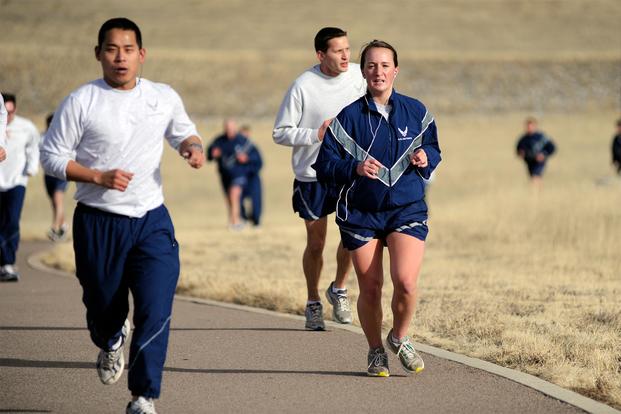One of the creators of the current Air Force physical fitness test believes he has found a way to do away with gender-specific scoring -- and less helpful exercises such as pushups and sit-ups -- in favor of a scientifically proven fitness measurement that would apply to all airmen equally.
Dr. Neal Baumgartner, head of the Air Force's Exercise Science Unit, this week told a quarterly meeting of the Defense Advisory Committee on Women in the Service (DACOWITS) that the unit was in the early stages of exploring an adaptation of the fitness-fatness index (FFI), a metric that would result in a single number defining troops' fitness.
"Chief [Kaleth O.] Wright, our [chief master sergeant of the Air Force], he's right there with us, he's been very supportive of our ESU efforts," Baumgartner told Military.com in an interview. "We're testing the buy-in, but again, nothing's official at this time. These are ideas and concepts that we're talking about. We're excited about it. We're gathering feedback. And right now the feedback for these ideas and plans is positive."
In its simplest form, the FFI number for airmen would be arrived at by taking a service member's VO2 max, or maximal oxygen uptake, which can be measured in a run time; and dividing that by his or her waist-to-height ratio.
"The hard part right now, and I wish there was a little bit more in the literature on this, is setting the thresholds," Baumgartner said. " ... What I don't know is where are the cut points yet of what's low, what's moderate and what's high for risk."
The Army is now in the process of implementing a new combat fitness test for all soldiers that is both gender- and age-neutral. The Army Combat Fitness Test, set to replace the current Army Physical Fitness Test in October 2020, consists of six events, including a two-mile run; strength deadlift; standing power throw; hand-release pushups; sprint-drag-carry event; and leg tuck.
In a presentation to DACOWITS March 19, G. Scott McConnell, deputy chief of staff for Operations and Plans at Army Training and Doctrine Command, said the service would closely monitor the effect of the new ACFT on performance across age and gender.
With 60 battalions across the Army conducting pilot tests, "It was not the dire event that folks thought it was going to be," McConnell said.
The current Navy and Marine Corps physical fitness tests are age and gender-normed, although the Marine Corps has recently made changes to require all troops -- male and female -- to perform pull-ups in order to attain a perfect score.
The current Air Force fitness test is gender and age-normed and combines a 1.5-mile run time with maximum pushup and sit-up repetitions in one minute. Points are assigned in each category to arrive at a total score of unsatisfactory, satisfactory or excellent.
Baumgartner said a proposed FFI-based test was likely to be gender-neutral, applying to all airmen in the same way. It also incorporates an assessment of central adiposity or abdominal fat, a key health measurement.
"The FFI takes care of the argument of the man who says, 'I can carry a big gut and run like the wind.' Statistically and physiologically I can tell you that's not true," Baumgartner said. "However, if the person still believes it's true or someone in their unit can do it, fine, let them go ahead and do it."
While such an airman would lose points on the waist measurement, he or she would have the opportunity to balance that with a faster run time, he said.
The proposed test is also likely to ditch the current max-rep exercises in favor of ones that offer a more scientific relation to fitness measurement.
"It is a health criterion, science-based test," he said. "For the muscle fitness test component, pushups and sit-ups, we do not have health criterion standards as there are not enough data in the literature to link these tests to health outcome, so these standards, unfortunately, end up being normative."
While it's not clear what could replace these exercises, Baumgartner mentioned the possibility of a randomized test, limiting an airman's ability to train to specific movements to ace the test.
"We need our airmen to regularly perform ... activities across the priority movement patterns of run-twist-bend-squat-pull-push," Baumgartner said.
Ultimately, he said, there could be five or six different possible tests, with airmen pulling a number to determine which test to execute.
"One might be doing a two-legged unloaded squat, while the next airman might be doing a cross-knee crunch," he said. "However, you'd need to be ready for all of these, [for a] better fitness outcome."
While Baumgartner said there was no timeline for moving forward with a new test, and discussions were all predecisional, he said early positive feedback was exciting.
"On a DACOWITS note, I receive strong comments from female officers and NCOs who say, make sure our standards aren't significantly lower," he said.
-- Hope Hodge Seck can be reached at hope.seck@military.com. Follow her on Twitter at @HopeSeck.












